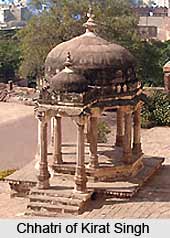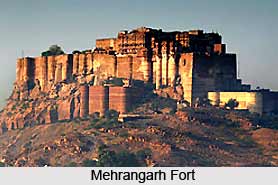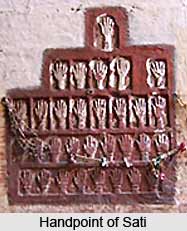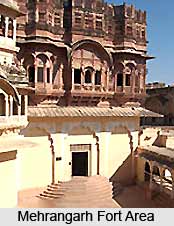 Rao Jodha, the chief of Rathore clan, got the Mehrangarh fort of Jodhpur constructed in 1459. It is situated on 150 m high hill and can be reached from the city through a circular road. It is one of the largest and most magnificent forts in India. Mehrangarh fort of Jodhpur, Rajasthan has 7 gates, which need to be crossed before reaching the main complex.
Rao Jodha, the chief of Rathore clan, got the Mehrangarh fort of Jodhpur constructed in 1459. It is situated on 150 m high hill and can be reached from the city through a circular road. It is one of the largest and most magnificent forts in India. Mehrangarh fort of Jodhpur, Rajasthan has 7 gates, which need to be crossed before reaching the main complex.
There is a chhatri of a soldier Kirat Singh Soda to the left of the Mehrangarh fort. He fell while defending the fort against the armies of Amber on the stop where the chhatri now stands. There is a gate named Jayapol (meaning victory) built by Maharaja Man Singh to celebrate the defeat of Jaipur and Bikaner. Maharaja Ajit Singh also constructed a gate called Fattehpol (meaning victory) to commemorate the win over Mughals. Another gate called Lohapol (meaning iron gate) has palm imprints of the queens of Maharaja Man who immolated them in an act of sati.
History
As with many other forts and palaces of Rajasthan, Mehrangarh too, encloses within its heart a legend that took birth during its construction. It is believed that to build a fort, a sage had to be forced out from the hill. Enraged, this sage cursed that the construction of the fort will see severe problems relating to water availability. To ward off the ramifications of this curse, a man offered to bury himself alive in the foundation of the fort. Today, this story has little credibility amongst tourists, though what is quieting obvious is that Mehrangarh Fort reminds them of the royal past of the Rajput. It is a legacy of the courageous denizens who once inhabited the fort.
 The then entrance consisted of a boulder, which had two holes in which were inserted wooden logs to provide a provisional barrier. Beyond the Lakhna Pol is the Loha Pol (Iron Gate) dating back to the 15th century, although the façade that you see today was again the contribution of Rao Maldeo in the 16th century. The handprints of 15 royal satis, Jodhpur queens who burnt themselves on the funeral pyres of their husbands, are a chilling reminder to the barbaric custom, which was very much in vogue in Rajasthan. It was the considered an honor by the women themselves to sacrifice their lives for their men folk.
The then entrance consisted of a boulder, which had two holes in which were inserted wooden logs to provide a provisional barrier. Beyond the Lakhna Pol is the Loha Pol (Iron Gate) dating back to the 15th century, although the façade that you see today was again the contribution of Rao Maldeo in the 16th century. The handprints of 15 royal satis, Jodhpur queens who burnt themselves on the funeral pyres of their husbands, are a chilling reminder to the barbaric custom, which was very much in vogue in Rajasthan. It was the considered an honor by the women themselves to sacrifice their lives for their men folk.
So much so, that when Maharaja Ajit Singh died in 1731, no fewer than six of his wives and fifty-eight of his concubines burnt themselves on his funeral pyre and although sati was made illegal by the British governor general William Bentick in 1829, the last recorded case of sati occurred in Jodhpur as recently as 1953. Just next to it is the Suraj Pol or Sun Gate, one of the oldest gates in the complex. This gate is one of the oldest in the Mehrangarh fort, and on entering it you will come across a flight of stairs, which takes you to the Moti Mahal, one of the loveliest palaces in the complex.
Site & Architecture
The fort, which has 36-meter high and 21-meter wide walls, is entered after crossing seven gates. Jayapol or the main gate is the starting point. Maharaja Man Singh, who ruled Jodhpur in the first part of the 19th century, to commemorate his victory over the army of Jaipur and Bikaner, built the gate. Fatehpol is another victory gate built by Maharaja Ajit Singh in 1708 to mark his victory over the Mughals. Out of other six gates, there is one more that is a victory gate, Lohpol. The Iron Gate preserves the handprints of the wives of Maharaja Man Singh who threw themselves in the sacred fire of their husband`s pyre. The handprints are considered extremely pious and have grown into a revered symbol. A number of devotees smear it with red powder and silver to show their respect for the royal ladies who preferred death to humiliation.
 The area within the fort is covered with beautiful palaces and spacious courtyards. The palaces, like the Moti Mahal (Pearl Palace), Phool Mahal (Flower Palace) and Sukh Mahal (Pleasure Palace), today serve as a museum. Entered through the Suraj Pol, the museum exhibits a wide range of collections of elephant carriages, maharaja`s palanquin, and covered palanquins for ladies, lethal weapons, small canons and paintings. The palaces themselves have an undeniable charm. For instance, the Moti Mahal has five alcoves along the west wall. Other small alcoves on the walls were meant to hold oil lamps. The ceilings are radiant with glass tiles and gold paints.
The area within the fort is covered with beautiful palaces and spacious courtyards. The palaces, like the Moti Mahal (Pearl Palace), Phool Mahal (Flower Palace) and Sukh Mahal (Pleasure Palace), today serve as a museum. Entered through the Suraj Pol, the museum exhibits a wide range of collections of elephant carriages, maharaja`s palanquin, and covered palanquins for ladies, lethal weapons, small canons and paintings. The palaces themselves have an undeniable charm. For instance, the Moti Mahal has five alcoves along the west wall. Other small alcoves on the walls were meant to hold oil lamps. The ceilings are radiant with glass tiles and gold paints.
Phool Mahal was the palace where traditional dance performances regaled the audience. The gold plated ceiling has images of various Maharajas of Jodhpur around it. The paintings that adorn the walls of the palace are the work of a single artist who, unfortunately died before completing his work. The regality of this palace is enhanced more so because of the stained glasses that seems to preserve the glitter of the gold platings.
The Umaid Mahal shines beautifully with glass tiles and the private chamber of Maharaja Thakhat Singh near Zhanki Mahal glows with lac paintings. The Zhanki Mahal, itself houses the cradles of the infant princes of Thakhat Singh. The Zenana Mahal is not far behind in beauty and displays magnificent latticework screens with over 150 designs. Other palaces like the Rang Mahal, Chandan Mahal and Throne Room are also delightful.

Other attractions of the Mehrangarh fort are as follows:
Galleries: There are a number of galleries in the Mehrangarh fort including elephant howdah gallery, palanquin gallery, daulat khana, armory gallery, paintings gallery, turbans gallery, etc.
Museum: Mehrangarh fort houses one of the finest museums of Rajasthan. The museum displays an array of items including old royal palanquins, arms, costumes, paintings, decorated period rooms, etc.
Apart from the palaces, there are one cenotaph and one temple worth visiting. The cenotaph, Chhatri of Kirit Singh Sodha, is situated to the right beyond the main entrance. The cenotaphs pay tribute to the valorous soldier, Kirit Singh, who laid down his life defending his land from the army of Jaipur. The Chamunda Devi Temple is located at the southern end of the fort and displays Durga in her furious mood.
A walk on the ramparts at this end provides some really eye-catching views of the old city. Numerous houses painted in blue colour instantly draw the attention of the tourists. In the earlier time, only Brahmins could get their house painted in blue, however, today more and more people use this colour to ward off the monotony of the desert region. It is also believed that the colour blue spreads freshness in the house and as such highly useful.



















